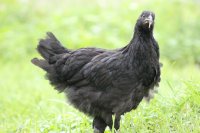Arizona Bob
In the Brooder
- Jul 31, 2017
- 7
- 25
- 23
I know this is a long story, but I have been following this website for 2 years and kept hens for 18 months, and only now, after my utter initial failures and more recent successes, do I feel I have a story to tell. Hope you enjoy, and thanks for reading!
In Feb 2016, I thought it would be cool to get chickens. A coworker of mine has raised a backyard flock in the city of Tucson for years, so I figured the several mountainous acres my wife and I live on in the Sonoran Desert of Arizona would be fine. We bought a 4-5 month old hen, half barred rock/half Americauna, whom we named Stella. She was all black and didn't really look like a chicken - at least not the white kinds I always saw on TV! (I admit, I was a TOTAL novice at the time.) She had spent her life in a large cage in a much larger enclosed structure for many other birds. I had bought a DIY coop and set it up under a tree and put 2 foot tall chicken wire around it. Stella's previous owner told us she hadn't laid an egg yet. An hour after arriving, she laid a green egg outside the coop! (See pic 1) As dark came, she didn't know how to get into the coop, so I coaxed her up the ramp using lettuce higher and higher until she went inside. Over the next 2 days, she explored her little area but would run away if we got too close. By the 3rd night, she knew to go up the ramp on her own at sunset.
Over the weekend, she seemed lonely, so we called the guy we bought her from and asked if he had any other chickens. He did – her actual mother hen! So we drove back out and bought Dora. (see pic 2) Sadly, the two fought as badly as a real mother and teenage daughter, especially when eating. Dora, having come from the same zoo-like home, also had no idea how to get up into the coop, so Stella led the way that first night. Stella was laying about every other day in the nesting box. Dora would not lay at all or even go up into the coop during the day. I got an old milk crate, filled it with shredded paper (idea from someone on this website!), and Dora went and sat in it immediately and laid an egg! She used the crate for about a week. Then one day, she just went up into the box to lay. Dora & Stella gave us a dozen eggs a week! (see pic 3)
I fed them their regular food (16% crumble), mixed with some scratch, and also mixed with their own dried egg shells crushed up. I have never used oyster shell, and we always have very strong eggshells. I also gave them veggie leaves from my garden and insects I catch in our bug zapper.
During our typical June heat (days up to 115F), we kept them cool by wetting the ground, providing pans of water for them to step in, and misting the air about once an hour. Both HATED to get wet! I also fed them chilled cucumbers, watermelon, and cold cooked corn kernals. They kept on laying. Neither allowed us to touch them, but they did eat from our hands.
In August 2016, we went on vacation, and on the 1st day away, the house-chicken sitters sent us a photo of a large coyote in our backyard. Both chickens had been taken. My wife cried all day. Not one problem in 6 months, so this was the last thing we expected. When we got home, she told me to move the coop out of her sight. The saddest part for us was that my wife works from home, so she would visit the chickens every 2 hours. They were part of her daily routine. The silence in the yard was deafening.
Another 6 months passed. It was now March 2017. My wife asked me what I wanted for my birthday. I told her a big, coyote-proof chicken coop! We hired a carpenter, and he built us what you see in photos 4 & 5. It’s a large, wood-framed screen house that is 9’wide, 12’long, 7’tall and fully enclosed with 1” wire all around, including the top. The ground around the outside also has chicken wire buried a foot deep and 2 feet wide in a u-shape to keep digging animals out. There is also a second layer of smaller-holed chicken wire two feet tall around the entire perimeter to keep baby chicks in and snakes (rattlers!) out. The original coop I assembled fits inside, with room for a second if needed.
We went to a farm and picked out a year-old Golden Wyandotte (Dora II) and 2 6-8 month old RI Reds (Veronica, Stella II). Unlike the first two, these 3 hens LOVED being held, petted, and hand-fed. They knew how to use a coop from the start, and we get 2-3 eggs a day.
In late April, Dora II went broody. She would sit on her egg or someone else’s all day, not eat or drink unless we hand-fed her, and refused to leave the coop! And for the 1st time, she squaked and pecked at me if I came close or tried to move her. After a week, we decided to buy a fertilized egg from a farmer and let her hatch it. On May 19, out came a baby chick as black as night. I mean BLACK – eyes, feet, feathers. I had avoided buying baby chicks due to all the things I’ve read on here: hen separation, heat lamps, special diet, low success rate, etc. With our new Lucy, we were worried about her health and safety. (We think she is an australorp).
I drove over to the local feed store where I buy their feed and asked, "What now?!?" The guy told me, “The pullet is with her mom. Let nature take its course. On day 3, take the baby out of the small coop and into the bigger coop when the rest are out in the yard. Mom will follow." (see pic 6) I made a separate area inside the bigger area just for Dora II and Lucy – separate food and water as well. They stayed out there all day until about 30 minutes before sunset. I placed the chick in the nesting box, & mom hurried in behind. Next evening, mom was pushing the baby up the ramp as sunset approached! By the end of the week, Lucy was able to get up & down the ramp on her own with her mom nudging behind just incase!
The June heat soon arrived, and despite multiple days at or above 115F (~45C), the RI Reds kept laying. Pic 7 shows them hanging out together in the cool, wet dirt. At that time, Dora II was too busy being a GREAT mom! She and Lucy were inseparable. (see pic 8) Only Stella, the next youngest, bothers Lucy occasionally, but Dora II always chases her away.
Lucy (10.5 weeks now), whom we thought might have been a boy (Lucifer) from about weeks 4-8, now appears to be a hen. Her mom, Dora II, finally laid her first egg today since late April - almost 14 weeks since her last one! All 4 are getting along well. (see pic 9)
Over the next few days, I will add what I've learned to different threads especially regarding their enclosure, diet, heat wave care, and pullet raising. I am very happy to be part of this unique community!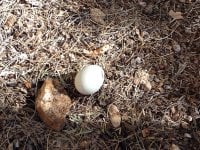
In Feb 2016, I thought it would be cool to get chickens. A coworker of mine has raised a backyard flock in the city of Tucson for years, so I figured the several mountainous acres my wife and I live on in the Sonoran Desert of Arizona would be fine. We bought a 4-5 month old hen, half barred rock/half Americauna, whom we named Stella. She was all black and didn't really look like a chicken - at least not the white kinds I always saw on TV! (I admit, I was a TOTAL novice at the time.) She had spent her life in a large cage in a much larger enclosed structure for many other birds. I had bought a DIY coop and set it up under a tree and put 2 foot tall chicken wire around it. Stella's previous owner told us she hadn't laid an egg yet. An hour after arriving, she laid a green egg outside the coop! (See pic 1) As dark came, she didn't know how to get into the coop, so I coaxed her up the ramp using lettuce higher and higher until she went inside. Over the next 2 days, she explored her little area but would run away if we got too close. By the 3rd night, she knew to go up the ramp on her own at sunset.
Over the weekend, she seemed lonely, so we called the guy we bought her from and asked if he had any other chickens. He did – her actual mother hen! So we drove back out and bought Dora. (see pic 2) Sadly, the two fought as badly as a real mother and teenage daughter, especially when eating. Dora, having come from the same zoo-like home, also had no idea how to get up into the coop, so Stella led the way that first night. Stella was laying about every other day in the nesting box. Dora would not lay at all or even go up into the coop during the day. I got an old milk crate, filled it with shredded paper (idea from someone on this website!), and Dora went and sat in it immediately and laid an egg! She used the crate for about a week. Then one day, she just went up into the box to lay. Dora & Stella gave us a dozen eggs a week! (see pic 3)
I fed them their regular food (16% crumble), mixed with some scratch, and also mixed with their own dried egg shells crushed up. I have never used oyster shell, and we always have very strong eggshells. I also gave them veggie leaves from my garden and insects I catch in our bug zapper.
During our typical June heat (days up to 115F), we kept them cool by wetting the ground, providing pans of water for them to step in, and misting the air about once an hour. Both HATED to get wet! I also fed them chilled cucumbers, watermelon, and cold cooked corn kernals. They kept on laying. Neither allowed us to touch them, but they did eat from our hands.
In August 2016, we went on vacation, and on the 1st day away, the house-chicken sitters sent us a photo of a large coyote in our backyard. Both chickens had been taken. My wife cried all day. Not one problem in 6 months, so this was the last thing we expected. When we got home, she told me to move the coop out of her sight. The saddest part for us was that my wife works from home, so she would visit the chickens every 2 hours. They were part of her daily routine. The silence in the yard was deafening.
Another 6 months passed. It was now March 2017. My wife asked me what I wanted for my birthday. I told her a big, coyote-proof chicken coop! We hired a carpenter, and he built us what you see in photos 4 & 5. It’s a large, wood-framed screen house that is 9’wide, 12’long, 7’tall and fully enclosed with 1” wire all around, including the top. The ground around the outside also has chicken wire buried a foot deep and 2 feet wide in a u-shape to keep digging animals out. There is also a second layer of smaller-holed chicken wire two feet tall around the entire perimeter to keep baby chicks in and snakes (rattlers!) out. The original coop I assembled fits inside, with room for a second if needed.
We went to a farm and picked out a year-old Golden Wyandotte (Dora II) and 2 6-8 month old RI Reds (Veronica, Stella II). Unlike the first two, these 3 hens LOVED being held, petted, and hand-fed. They knew how to use a coop from the start, and we get 2-3 eggs a day.
In late April, Dora II went broody. She would sit on her egg or someone else’s all day, not eat or drink unless we hand-fed her, and refused to leave the coop! And for the 1st time, she squaked and pecked at me if I came close or tried to move her. After a week, we decided to buy a fertilized egg from a farmer and let her hatch it. On May 19, out came a baby chick as black as night. I mean BLACK – eyes, feet, feathers. I had avoided buying baby chicks due to all the things I’ve read on here: hen separation, heat lamps, special diet, low success rate, etc. With our new Lucy, we were worried about her health and safety. (We think she is an australorp).
I drove over to the local feed store where I buy their feed and asked, "What now?!?" The guy told me, “The pullet is with her mom. Let nature take its course. On day 3, take the baby out of the small coop and into the bigger coop when the rest are out in the yard. Mom will follow." (see pic 6) I made a separate area inside the bigger area just for Dora II and Lucy – separate food and water as well. They stayed out there all day until about 30 minutes before sunset. I placed the chick in the nesting box, & mom hurried in behind. Next evening, mom was pushing the baby up the ramp as sunset approached! By the end of the week, Lucy was able to get up & down the ramp on her own with her mom nudging behind just incase!
The June heat soon arrived, and despite multiple days at or above 115F (~45C), the RI Reds kept laying. Pic 7 shows them hanging out together in the cool, wet dirt. At that time, Dora II was too busy being a GREAT mom! She and Lucy were inseparable. (see pic 8) Only Stella, the next youngest, bothers Lucy occasionally, but Dora II always chases her away.
Lucy (10.5 weeks now), whom we thought might have been a boy (Lucifer) from about weeks 4-8, now appears to be a hen. Her mom, Dora II, finally laid her first egg today since late April - almost 14 weeks since her last one! All 4 are getting along well. (see pic 9)
Over the next few days, I will add what I've learned to different threads especially regarding their enclosure, diet, heat wave care, and pullet raising. I am very happy to be part of this unique community!

Attachments
-
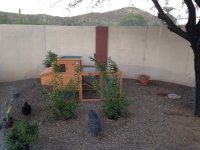 Stella I and Dora I Original Coop.jpg493.2 KB · Views: 11
Stella I and Dora I Original Coop.jpg493.2 KB · Views: 11 -
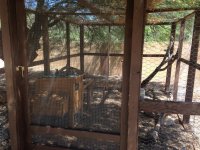 New Enclosure Front.jpg325.2 KB · Views: 10
New Enclosure Front.jpg325.2 KB · Views: 10 -
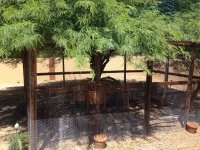 New Enclosure Side.jpg259.1 KB · Views: 10
New Enclosure Side.jpg259.1 KB · Views: 10 -
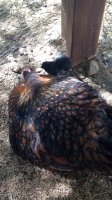 Dora II & Lucy (day 2 pullet).jpg366.5 KB · Views: 10
Dora II & Lucy (day 2 pullet).jpg366.5 KB · Views: 10 -
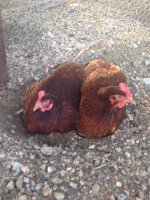 Stella II & Veronica.jpg366.3 KB · Views: 10
Stella II & Veronica.jpg366.3 KB · Views: 10 -
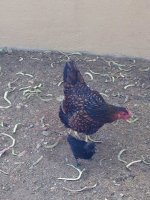 Dora II & Lucy (pullet day 32).jpg542.2 KB · Views: 10
Dora II & Lucy (pullet day 32).jpg542.2 KB · Views: 10 -
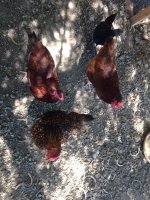 Dora II, Stella II, Veronica & Lucy (day 73!).jpg228.6 KB · Views: 10
Dora II, Stella II, Veronica & Lucy (day 73!).jpg228.6 KB · Views: 10






